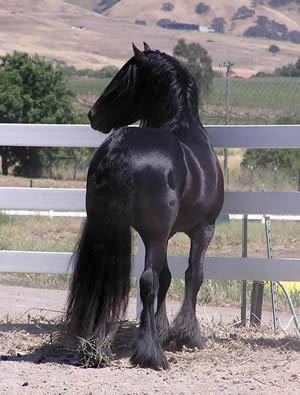History
The Dales Pony is native to the eastern slopes of the English Pennines, known as the Yorkshire Dales. It was originally bred as a pack pony for the flourishing lead industry. A team of up to twenty ponies would be led, untethered, by one rider. They would travel up to fifty miles as day over rough country at great speed, carrying two panniers each loaded with 110 lbs. of supplies, to enable the lead, ore and fuel to be delivered to the north eastern ports, up to 250 miles away, as quickly as possible. Then returning the same distance with supplies of coal to fuel the mines. This led to their gaining the reputation for great strength, endurance, agility and intelligence. Over the years they became a great favorite with the military, and in 1513 were selected principally by gait, the preference being for ponies of "trotting" type. During the 17th century when the Scottish Galloway was considered the best pack pony, infusions of Galloway blood and later Black Galloway was introduced into the Dales and Fells. This infusion brought with it their tendency for deep clean legs, improved speed and surefootedness over rugged terrain. The quality that can still be seen in the Dales of today.
Not only are the Dales known for their attributes aforementioned, but also for their versatility in other areas. It was also recognized for its comfortable riding gaits as well as its ability as a draft animal. Farmers would expect their Dales' ponies to put in a full weeks work in the field. Plowing and reaping, carrying up to 160 lbs. of hay, often with rider, as well as, rounding up sheep on the fells and dales were some of their duties. Then on Saturday, they would take the farmer to market in style. Being rather fine jumpers they would even, on occasion, take the farmer on a good day's foxhunting. So when the Dales' found themselves outdated in the mining industry, by trains and trucks, they established a stronger foothold working on the farm. Yorkshiremen also loved the trotting races but as it was uneconomical to keep extra ponies, just for racing, they inventively bred the best Norfolk and Yorkshire trotter to Dales mares and produced foals with a fast flashy trot. This is where the Dales acquired the wonderful gait for which they are renowned today.
The Dales Ponies attributes of strength, endurance, agility and courage made them very attractive to the military. Many Dales ponies were conscripted for the First World War, 200 alone during the period of 1923-24. There is a true story of one small farmer who, while his beloved Dales Pony stood hidden in his kitchen, entertained an army captain who was seeking out ponies which had not yet been brought forward in his sitting room. They were also taken during the Second World War for pulling artillery, munitions and supplies. Their compact size made them easier to ship in numbers than some of the bigger draft horses. This popularity nearly led to their total extinction. Ponies that were not killed in action were left behind to end up on the tables of the starving Europeans after the war was over. Many more were to die after the war, when with the return of the truck and car, horses and ponies that were no longer needed were shipped in the thousands to the slaughterhouses of Europe. In 1955, only four filly foals were registered and it looked as though the breed was doomed. Were it not for the dedication of a number of Dales devotees the breed might have been lost forever.
The Dales Pony Improvement Society had been founded in 1916 and a stud book opened within the National Pony Society's stud book. After World War II, The Dales Pony Improvement Society had to be radically reorganized in order to save the dying breed. First, Improvement was dropped from the title. Then some new measures for increasing number introduced, the most far-sighted of these being the introduction of a grading up register. Dales Pony enthusiasts scoured the area for unregistered ponies conforming to breed standard and those which had lost their papers. These ponies were critically inspected and placed on the register. Their progeny was then upgraded accordingly. The result of these measures was to increase the number and quality of ponies bred. By 1971, the results had been so successful that the grading up register was closed. Dales have been upgraded from the "in danger of extinction category" on the endgangered species list and now reside in the rare breed category, presently they number somewhere in the six hundreds.
Behavior
True pony character. Alert, high couraged, intelligent and kind.
Function
Dales ponies today compete in show jumping, cross-country, dressage, driving, and eventing. Their calm, kind temperament, combined with their ability to carry heavy weights for long distances, has made them an ideal pony for endurance riding and trekking holidays, as they can carry novice or experienced riders, adults or children alike, over all kinds of terrain and for long distances. Small herds still roam free in the eastern Pennines, and in 2007 there were estimated to be around 30 mares of breeding age in feral herds.






